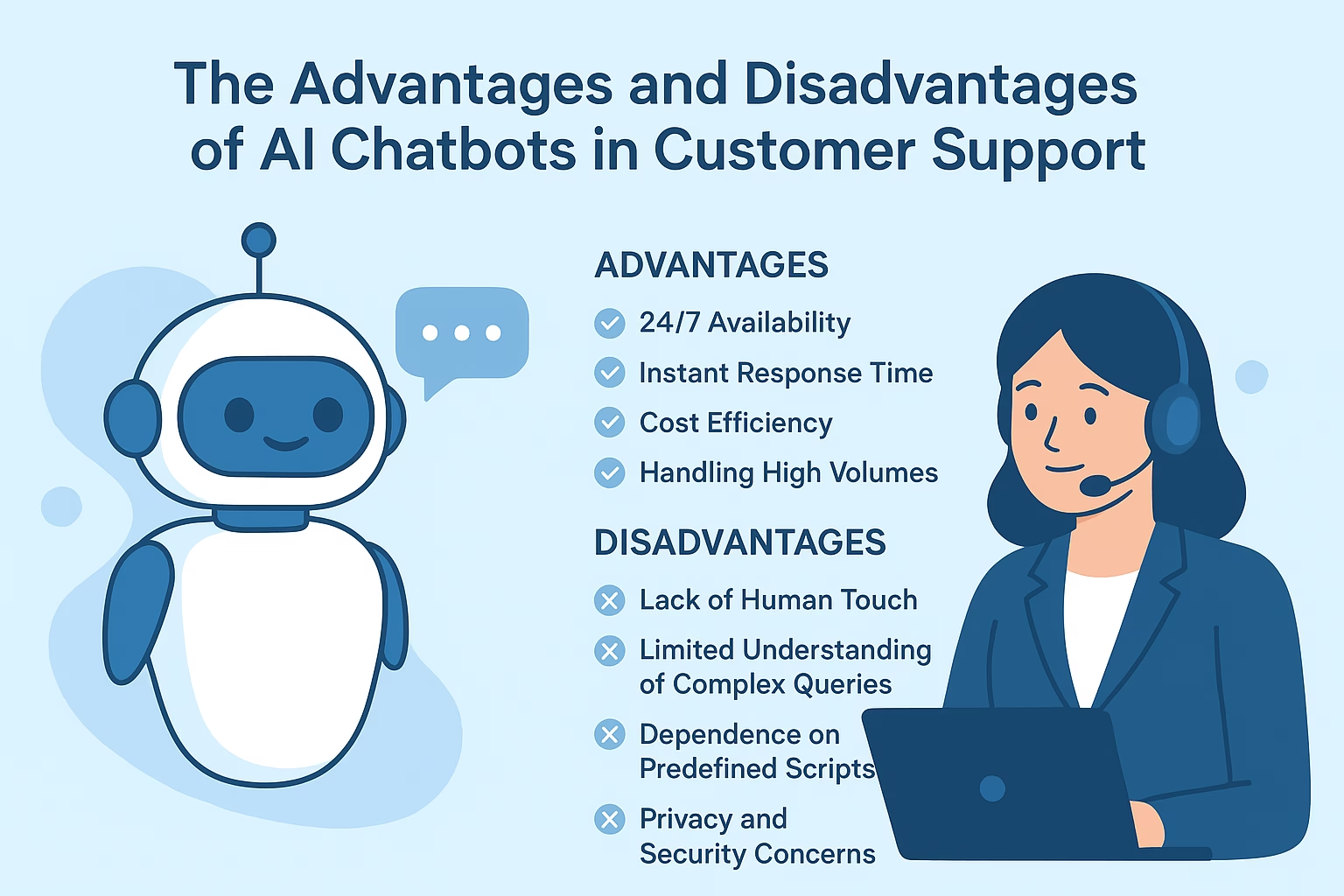In today’s fast-paced digital world, customers expect instant responses and seamless support. This is where AI chatbots for customer support have emerged as a game-changer. By automating responses, streamlining communication, and providing 24/7 assistance, AI chatbots are transforming how businesses engage with their customers.
However, while they bring numerous benefits, they also have limitations that cannot be ignored. In this article, we’ll explore both the advantages and disadvantages of AI chatbots in customer support, helping businesses make informed decisions about integrating them into their operations.
What Are AI Chatbots for Customer Support?
AI chatbots for customer support are software applications powered by artificial intelligence that simulate human conversation through chat interfaces. They can be integrated into websites, apps, social media platforms, and messaging services. AI chatbots range from rule-based bots, which follow predefined scripts, to advanced AI-powered bots that use natural language processing (NLP) and machine learning to understand and respond to complex queries.
These bots can perform a variety of tasks, including answering FAQs, processing orders, assisting with troubleshooting, and even escalating issues to human agents when necessary. Their ability to automate repetitive tasks makes them an invaluable tool for businesses of all sizes.
Advantages of AI Chatbots in Customer Support
1. 24/7 Availability
One of the most significant advantages of AI chatbots is their ability to provide round-the-clock support. Unlike human agents who work in shifts, chatbots can operate continuously without breaks, ensuring that customers receive instant assistance at any hour. This is particularly valuable for global businesses that serve customers in different time zones.
2. Instant Response Time
AI chatbots offer instant responses to customer queries, significantly reducing wait times. Quick responses enhance customer satisfaction, improve engagement, and prevent frustration. Customers no longer have to wait in long queues for support, making the overall experience smooth and efficient.
3. Cost Efficiency
Hiring and training a large customer support team can be expensive. AI chatbots help businesses cut costs by handling multiple queries simultaneously without the need for additional staff. This allows companies to allocate human resources to more complex tasks while chatbots manage routine inquiries.
4. Handling High Volumes
During peak hours or promotional campaigns, the volume of customer queries can skyrocket. AI chatbots can efficiently manage hundreds or even thousands of conversations at once, ensuring that no customer is left waiting. This scalability is a significant advantage over relying solely on human agents.
5. Consistent Customer Experience
AI chatbots provide consistent responses and service quality, reducing the chances of errors caused by human agents. Customers receive accurate and uniform information every time, which helps build trust and reliability.
Disadvantages of AI Chatbots in Customer Support
1. Lack of Human Touch
While AI chatbots are efficient, they lack empathy and emotional intelligence. Customers with sensitive issues or complex problems may feel frustrated when interacting with a bot instead of a human. This limitation can negatively impact customer satisfaction if not managed properly.
2. Limited Understanding of Complex Queries
Despite advancements in NLP, AI chatbots may struggle to understand nuanced or highly complex queries. Ambiguous language, sarcasm, or multi-step problems can confuse the bot, leading to incorrect responses or unnecessary escalation to human agents.
3. Dependence on Predefined Scripts
Rule-based chatbots rely heavily on predefined scripts. This limits their ability to handle unexpected queries or adapt to unique situations. While AI-powered bots are smarter, they still require continuous training and updates to stay effective.
4. Privacy and Security Concerns
AI chatbots handle sensitive customer data, such as personal details and payment information. Improper implementation can expose this data to security risks, including breaches and unauthorized access. Businesses must ensure robust security measures are in place to protect customer information.
When to Use AI Chatbots for Customer Support
AI chatbots work best in scenarios involving repetitive tasks, standard queries, or high-volume support. Industries like e-commerce, banking, travel, and telecommunications benefit immensely from chatbots handling order tracking, account inquiries, booking services, and more. Complex issues that require empathy or judgment, however, are better handled by human agents.
Best Practices for Implementing AI Chatbots
- Start with a clear goal: Identify the specific problems your chatbot will solve.
- Train the bot continuously: Use real conversation data to improve accuracy and understanding.
- Provide human escalation: Always offer an option to connect with a human agent.
- Maintain personalization: Use customer data to create personalized responses.
- Monitor performance: Track key metrics like response time, satisfaction score, and resolution rate.
AI Chatbots vs Human Agents
While AI chatbots excel in efficiency, speed, and scalability, human agents provide empathy, judgment, and adaptability. A hybrid approach, combining chatbots for routine tasks and human agents for complex issues, often delivers the best results. Businesses can benefit from reduced costs without compromising the quality of customer interactions.
Future of AI Chatbots in Customer Support
The future of AI chatbots for customer support looks promising. Advancements in NLP, machine learning, and sentiment analysis will make chatbots more intuitive, capable of understanding emotions, context, and complex queries. We can expect AI chatbots to handle increasingly sophisticated tasks while maintaining personalized, human-like interactions.
Conclusion
AI chatbots for customer support offer numerous advantages, including 24/7 availability, instant responses, cost efficiency, and consistent service quality. However, they are not without drawbacks, such as the lack of human touch, limited understanding of complex queries, and potential security concerns. The key to success lies in finding the right balance—leveraging AI chatbots for routine tasks while reserving human agents for complex or sensitive interactions. By implementing best practices and continuously optimizing the system, businesses can deliver superior customer experiences while maximizing operational efficiency.







